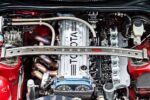Compression in Diesel Engine
When it comes to diesel engines, compression is the name of the game. Unlike gasoline engines that rely on spark plugs to ignite the air-fuel mixture, diesel engines operate on a different principle. They compress air to such high pressures and temperatures that the fuel ignites spontaneously when injected. This fundamental difference is what gives diesel engines their unique characteristics, including better fuel efficiency and higher torque output.
Understanding how compression works in a diesel engine is crucial for anyone looking to maintain or repair these robust machines. The compression ratio, which is the ratio of the maximum to the minimum cylinder volume, plays a significant role in the performance and efficiency of the engine. Typical diesel engines operate at compression ratios between 14:1 and 25:1, which is significantly higher than their gasoline counterparts. This high compression leads to a more complete combustion of fuel, resulting in better fuel economy and reduced emissions.
The Role of Compression in Performance
High compression ratios contribute not only to fuel efficiency but also to the overall power output of the engine. When the air is compressed to high pressures, it heats up, which allows for a more efficient burn of the injected fuel. This means that diesel engines can produce more torque at lower RPMs, making them ideal for heavy-duty applications like trucks and construction equipment.
However, the benefits of high compression come with some caveats. Increased pressure can lead to higher temperatures, which may cause engine knock if not managed properly. Additionally, the materials used in diesel engines must withstand these extreme conditions, which can add to the cost of repairs and maintenance. Understanding these dynamics is essential for anyone working on diesel engines, whether you’re a seasoned mechanic or a DIY enthusiast.
In the following sections, we will delve deeper into the mechanics of compression in diesel engines, exploring the implications for performance, maintenance, and troubleshooting. Buckle up; it’s going to be a bumpy ride through the world of diesel technology.
Understanding Diesel Engine Compression
When diving deeper into diesel engine mechanics, one cannot overlook the critical role of compression. It’s not just about cranking up the pressure; it’s about how that pressure affects the entire combustion process, fuel efficiency, and engine longevity. Let’s break down the key aspects of compression in diesel engines, including its mechanics, implications, and maintenance considerations.
The Mechanics of Compression
Compression in a diesel engine occurs during the compression stroke, where the piston moves upward in the cylinder. As the piston ascends, the volume of the cylinder decreases, leading to an increase in pressure and temperature. This process is crucial because it prepares the air for the injection of fuel, which will ignite due to the heat generated by compression.
Compression Ratio Explained
The compression ratio (CR) is a vital parameter in diesel engines. It is defined as the ratio of the cylinder volume at the bottom of the stroke to the cylinder volume at the top of the stroke. A typical diesel engine might have a CR ranging from 14:1 to 25:1. Here’s a simple breakdown:
| Engine Type | Typical Compression Ratio |
|---|---|
| Light-Duty Diesel | 14:1 to 18:1 |
| Heavy-Duty Diesel | 18:1 to 25:1 |
| High-Performance Diesel | 25:1+ |
Higher compression ratios generally lead to better thermal efficiency, but they also demand more robust engine components to withstand the increased stress and heat.
Impact on Performance and Efficiency
The relationship between compression and performance in diesel engines is straightforward: higher compression ratios yield better efficiency and power. When the air is compressed, it heats up, allowing for a more effective burn of the injected fuel. This results in:
- Increased torque at lower RPMs
- Improved fuel economy
- Lower emissions of unburned fuel
However, there are trade-offs. For instance, while higher compression ratios can enhance performance, they can also lead to issues such as engine knock or premature wear of components if not properly managed.
Engine Knock and Its Causes
Engine knock, also known as detonation, occurs when the fuel-air mixture ignites prematurely. This can be particularly problematic in high-compression diesel engines. Here are some common causes:
- Poor quality fuel with low cetane ratings
- Overheating due to inadequate cooling
- Incorrect timing of fuel injection
Addressing these issues is crucial for maintaining engine health and performance.
Maintenance Considerations
Maintaining proper compression is essential for the longevity of a diesel engine. Regular checks and maintenance can prevent costly repairs down the line. Here are some key maintenance tips:
- Regularly inspect and replace air filters to ensure proper airflow.
- Use high-quality fuel to prevent deposits that can affect compression.
- Monitor engine temperatures and ensure the cooling system is functioning correctly.
- Check for wear in piston rings and cylinder walls, as these can lead to compression loss.
Compression Testing
One of the best ways to assess the health of a diesel engine is through compression testing. This involves using a compression gauge to measure the pressure in each cylinder. Here’s a simple table of what to look for:
| Cylinder Pressure (psi) | Condition |
|---|---|
| 300+ psi | Good condition |
| 200-300 psi | Needs attention |
| Below 200 psi | Significant issues likely |
In conclusion, understanding the intricacies of compression in diesel engines is vital for anyone involved in their maintenance or repair. It’s not just about the numbers; it’s about how those numbers translate into real-world performance and longevity. Keep your engine’s compression in check, and you’ll reap the benefits of this powerful technology.




0 Comments